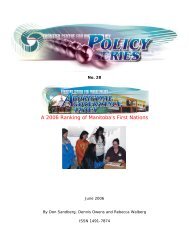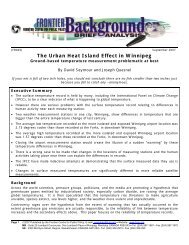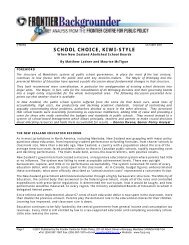The New Paradigm - Federal Reserve Bank of Dallas
You also want an ePaper? Increase the reach of your titles
YUMPU automatically turns print PDFs into web optimized ePapers that Google loves.
18<br />
Exhibit 12<br />
Mind Your Ps and Qs<br />
<strong>The</strong> concepts <strong>of</strong> price level (P) and aggregate quantity (Q) are highly<br />
dubious. Nonetheless, statisticians persist in creating these two<br />
measures, which are scrutinized out to their third digit. Perhaps the<br />
biggest loss <strong>of</strong> usefulness from aggregating output is caused by<br />
combining industries whose returns to scale are increasing with<br />
those whose returns are decreasing. <strong>The</strong> effect <strong>of</strong> an increase in<br />
demand on prices depends on whether raising output drives average<br />
costs up or down. Average costs usually rise in industries with<br />
mostly variable production costs. <strong>The</strong> industries that dominated<br />
P S<br />
yesterday’s material world (such as agriculture, mining, construction<br />
and heavy manufacturing) and much <strong>of</strong> the less-skilled services<br />
economy (household, personal, repair and cleaning services, for<br />
example) are in this category. But for many other, <strong>of</strong>ten newer, sectors<br />
<strong>of</strong> the economy (such as computer hardware and s<strong>of</strong>tware,<br />
communications and pharmaceuticals), average costs <strong>of</strong>ten decline<br />
as output expands because high fixed costs are spread over a large<br />
number <strong>of</strong> buyers. To the extent that economic expansion comes in<br />
industries <strong>of</strong> the latter type, GDP can grow without the inflationary<br />
consequences <strong>of</strong>ten feared.<br />
P S<br />
D 1 D 2<br />
D 1 D 2<br />
P 2<br />
P 1<br />
Q 1 Q 2 Q<br />
P 1<br />
P 2<br />
Q 1 Q 2 Q<br />
up prices for scarce inputs. Production costs for additional<br />
units rise, slowly at first but then more rapidly.<br />
<strong>The</strong> bottom line: as Industrial Age companies expanded<br />
operations, they had little choice but to raise prices to<br />
cover higher costs. In an economy dominated by risingcost<br />
industries, additional demand can ignite inflation. It’s<br />
this view <strong>of</strong> basic costs, accurate for an industrial economy,<br />
that led analysts to conclude that rapid growth can<br />
threaten price stability.<br />
<strong>The</strong> Information Age gave birth to companies and<br />
industries with a decidedly different cost structure. <strong>The</strong>ir<br />
output exhibits increasing returns to scale over a wide<br />
range <strong>of</strong> products. Instead <strong>of</strong> rising with additional output,<br />
average costs continue to slope downward. (See Exhibit<br />
12.) Goods and services become cheaper to produce as<br />
the size <strong>of</strong> the market increases. This gives companies a<br />
powerful incentive for aggressive pricing, including quantity<br />
discounts.<br />
Information Age enterprises need more customers to<br />
recoup their investment in new-product development.<br />
Today, bigger is <strong>of</strong>ten better, which helps explain the surge<br />
in mergers and acquisitions in the 1990s. Companies combine<br />
to capture the advantages that come from downward<br />
sloping long-run average cost curves. (See Exhibit 13.)<br />
What frees today’s technology from the old model <strong>of</strong><br />
increasing costs? It’s partly changes in the nature <strong>of</strong> what<br />
we produce. Yesterday’s goods and services had a “rivalry”<br />
in consumption, in which one person’s purchase barred<br />
anyone else’s. In the <strong>New</strong> Economy, more companies<br />
make products—such as information and entertainment—<br />
that don’t disappear or even degrade with use. <strong>The</strong>y can<br />
satisfy many consumers at the same time, so additional<br />
demand doesn’t lead to shortages.<br />
Moreover, many <strong>New</strong> Economy businesses connect<br />
people. It’s expensive to link one or two users in a network,<br />
but it’s far less costly to add customers once the delivery<br />
1999 ANNUAL REPORT <strong>Federal</strong> <strong>Reserve</strong> <strong>Bank</strong> <strong>of</strong> <strong>Dallas</strong>

















